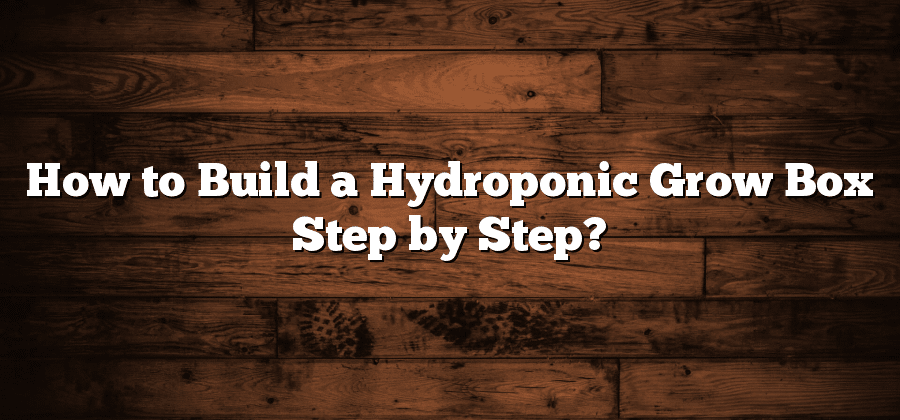Understanding the Basics of Hydroponics
Hydroponics is a unique method of growing plants without soil. Instead, it utilizes specially formulated nutrient solutions that are dissolved in water to nourish the plants directly. This innovative approach offers several advantages over traditional soil-based farming, making it an attractive option for both commercial farmers and home gardeners.
One of the primary benefits of hydroponics is the ability to control and optimize plant growth conditions. By providing precise levels of nutrients, water, and light, growers can tailor the environment to match the specific needs of each plant. This results in faster growth rates, higher yields, and healthier plants overall. Additionally, since the plants are not exposed to soil-borne diseases and pests, hydroponic systems are less susceptible to these common problems, reducing the need for chemical pesticides and herbicides.
Selecting the Right Materials for Your Hydroponic Grow Box
When it comes to selecting the right materials for your hydroponic grow box, there are several key factors to consider. The first is durability. Since your grow box will be exposed to water, humidity, and potentially harsh conditions, it’s important to choose materials that can withstand these elements over time. This may include materials such as PVC, acrylic, or stainless steel.
Another important factor to consider is light reflection. Your grow box should be able to reflect and distribute light evenly to maximize plant growth. Materials with high reflective properties, such as Mylar or white paint, are often used to line the interior of the grow box.
In addition to durability and light reflection, it’s important to consider the availability and affordability of the materials. Some materials may be more readily available or cost-effective, making them a practical choice for your hydroponic grow box. An assessment of your budget and the availability of materials in your area can help you make an informed decision.
Designing and Planning Your Hydroponic Grow Box Layout
When it comes to designing and planning your hydroponic grow box layout, there are several key factors to consider. First and foremost, you’ll want to determine the size and dimensions of your grow box. This will largely depend on the space you have available and the number of plants you intend to grow. It’s important to ensure that your grow box is large enough to accommodate your plants and their root systems, while also allowing for proper ventilation and air circulation.
Next, consider the lighting requirements for your plants. Different plants have different light needs, so it’s crucial to select the right type of grow lights and position them appropriately within your grow box. LED lights are often preferred for hydroponic systems due to their energy efficiency and customizable spectrum options.
In addition to lighting, you’ll also need to plan for your nutrient delivery system. This includes determining the best placement for your reservoir, pumps, and plumbing. Proper water flow and circulation are essential for the success of your hydroponic system, so take the time to carefully plan out these components.
As you design and plan your hydroponic grow box layout, don’t forget to consider the accessibility and organization of your setup. It’s important to be able to easily access your plants for maintenance and harvesting, so leave enough space between rows or sections. Additionally, labeling and organizing your plants can help you keep track of their progress and ensure that each one receives the specific nutrients it requires.
By carefully considering these factors and mapping out your hydroponic grow box layout, you’ll be setting yourself up for success in your indoor gardening endeavors.
Assembling the Frame and Structure of Your Grow Box
One of the key steps in setting up your hydroponic grow box is assembling the frame and structure. This is crucial as it provides support for the various components of your system and ensures stability throughout the entire growing process. When selecting the materials for your frame, it’s important to consider factors such as durability, strength, and resistance to moisture. Opting for materials like sturdy PVC pipes or metal rods can provide the necessary stability for your grow box. Additionally, consider the size and dimensions of your grow box and ensure that the frame is appropriately sized to accommodate all the components within it.
Once you have gathered all the necessary materials, it’s time to start assembling the frame of your hydroponic grow box. Begin by carefully measuring and marking the dimensions for your frame, ensuring accuracy and precision. Next, using appropriate tools, cut the chosen materials to the required lengths and attach them together using connectors or fittings specifically designed for the chosen materials. Take care to align the components properly and secure them tightly to prevent any wobbling or instability. As you assemble the frame, periodically recheck your measurements and make any necessary adjustments to ensure everything fits perfectly.
Setting Up the Hydroponic System and Nutrient Solution
Once the frame and structure of your hydroponic grow box is assembled, it is time to set up the hydroponic system and nutrient solution. This is a crucial step in ensuring the success of your hydroponic garden.
First, you will need to choose the right type of hydroponic system for your specific needs. There are various options available such as deep water culture, nutrient film technique, and drip irrigation. Each system has its own advantages and disadvantages, so it is important to research and understand which one will work best for your plants and setup. Additionally, you will need to select the right nutrient solution for your hydroponic system. The nutrient solution provides the essential elements and minerals that plants need to grow and thrive. It is important to use a high-quality nutrient solution that is specifically formulated for hydroponic gardening. Achieving the correct balance of nutrients is crucial for healthy plant growth, so following the instructions provided by the manufacturer is essential.






